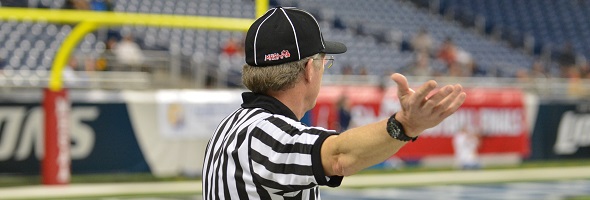
Be the Referee: Automatic 1st Downs
October 16, 2014
This week, MHSAA assistant director Mark Uyl explains the differences between high school and college and pro football when it comes to awarding automatic first downs.
"Be the Referee" is designed to help educate people on the rules of different sports, to help them better understand the art of officiating and to recruit officials. The segment can be heard on Mondays, Wednesdays and Fridays during the school year on The Drive With Jack Ebling on WVFN-AM, East Lansing.
Below is this week's segment - Automatic First Downs - Listen
Today we are going to talk about one of the biggest rule difference areas in high school football from those rules used in college and pro games and that deals with automatic first downs.
When watching that college game on Saturday or the pro game on Sunday, all of us know there are several defensive fouls that give the offense an automatic first down. However, under high school rules, the opposite is true most of the time.
The only high school fouls that result in an automatic first down for the offense are the roughing fouls - roughing the passer, the kicker, the holder and the long snapper. Fouls such as defensive pass interference or any other personal foul do not bring an automatic first down under high school rules.
Past editions
Oct. 8 - Officials & Injuries - Listen
Oct. 1 - Overtime - Listen
Sept. 25 - Field Goals - Listen
Sept. 18 - Tackle Box - Listen
Sept. 11 - Pass Interference - Listen
Aug. 25 - Targeting - Listen

Be the Referee: Illegal Football Kick
October 22, 2020
This week, MHSAA officials coordinator Sam Davis presents a "You Make the Call" on the legality of a kicking scenario.
Be The Referee is a series of short messages designed to help educate people on the rules of different sports, to help them better understand the art of officiating, and to recruit officials.
Below is this week's segment - You Make the Call: Illegal Kick - Listen
Here’s a you-make-the-call situation today. It’s fourth down and a field goal is being attempted – but the holder muffs the snap. With the loose ball rolling around, the kicker swings his leg at it and boots it through the uprights. You make the call – is this legal?
There are only two ways a ball can be legally kicked for points on a play which starts with a snap from center. One is a place kick being held by another player – the other is the rarely seen drop kick.
Had the kicker picked up the ball, dropped it to the ground and kicked it on the bounce through the uprights, the result of the play would have been a field goal. In this instance, though, a 10-yard penalty is assessed from the line of scrimmage for illegal kicking, and the opposing team takes over from that spot.
Past editions
10/15: Toe the Line on Penalty Kicks - Listen
10/8: Disconcerting Acts - Listen
10/1: Ball Hits Soccer Referee - Listen
9/24: Clocking the Ball from the Shotgun - Listen

